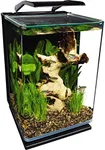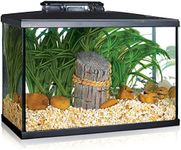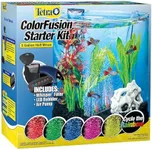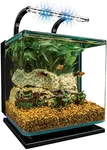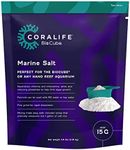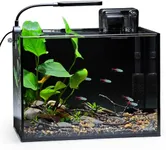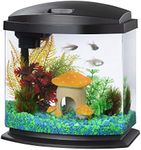Buying Guide for the Best Small Aquariums
Choosing the right small aquarium involves understanding your needs and the needs of the fish or aquatic life you plan to keep. Small aquariums are great for beginners, limited spaces, or as a decorative piece. However, they require careful consideration to ensure a healthy environment for your aquatic pets. Here are some key specifications to consider when selecting a small aquarium.Size (Capacity)The size or capacity of an aquarium is measured in gallons or liters. This spec is crucial because it determines how many fish you can keep and how stable the water conditions will be. Smaller tanks (1-5 gallons) are suitable for a single small fish or shrimp, but they require more frequent maintenance. Medium small tanks (5-10 gallons) can house a few small fish and are easier to maintain. Larger small tanks (10-20 gallons) offer more stability and can support a small community of fish. Choose a size based on the number and type of fish you want to keep, and remember that larger tanks are generally easier to maintain.
ShapeAquariums come in various shapes, such as rectangular, cube, and cylindrical. The shape affects the surface area for gas exchange and the swimming space for fish. Rectangular tanks provide more surface area and are generally better for fish health. Cube tanks are compact and stylish but may have less surface area. Cylindrical tanks are visually appealing but can distort the view of the fish. Choose a shape that fits your space and aesthetic preferences while considering the well-being of your fish.
MaterialAquariums are typically made from glass or acrylic. Glass tanks are more scratch-resistant and provide clearer views, but they are heavier and can break more easily. Acrylic tanks are lighter and more impact-resistant, making them easier to move and less likely to crack, but they can scratch more easily. Consider where you will place the tank and how often you might need to move it when choosing the material.
Filtration SystemA good filtration system is essential for maintaining water quality and keeping your fish healthy. Filters come in different types, such as internal, hang-on-back, and sponge filters. Internal filters are compact and fit inside the tank, making them suitable for small spaces. Hang-on-back filters are efficient and easy to maintain but require some space behind the tank. Sponge filters are gentle and ideal for small tanks with delicate fish or shrimp. Choose a filtration system that matches the size of your tank and the needs of your aquatic life.
LightingProper lighting is important for the health of your fish and any live plants in the aquarium. LED lights are energy-efficient and provide a range of colors and intensities. Fluorescent lights are also common but consume more energy. The lighting should mimic natural daylight to support the biological rhythms of your fish and promote plant growth. Consider the type of fish and plants you have when selecting the lighting, and ensure it is adjustable to meet their needs.
HeatingMany fish require a stable water temperature to thrive. Heaters are used to maintain the appropriate temperature in the tank. Submersible heaters are placed inside the tank and are suitable for small aquariums. In-line heaters are installed in the filtration system and are less common in small tanks. Choose a heater with an adjustable thermostat to maintain the ideal temperature for your specific fish species.
AccessoriesAccessories such as decorations, substrate, and plants can enhance the appearance of your aquarium and provide hiding places for fish. Decorations should be safe for fish and not alter the water chemistry. Substrate, like gravel or sand, should be chosen based on the needs of your fish and plants. Live plants can improve water quality and provide a natural environment, but they require proper lighting and care. Choose accessories that create a comfortable and stimulating environment for your fish.
